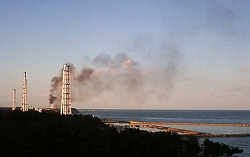High radiation dose readings
marked in spots in Tokyo, Chiba

Fukushima Power Plant
EMF Protection Devices
Magnetic Field Detector
TOKYO
(Kyodo) -- High radiation doses were reported Thursday in
spots in Tokyo and neighboring Chiba Prefecture, both over
200 kilometers away from the crippled Fukushima Daiichi
nuclear plant, with their readings found to exceed current
dose levels in some evacuation zones around the plant.
Airborne
radiation of up to 3.35 microsieverts per hour was recorded
Thursday along a sidewalk in a residential area in Tokyo's
Setagaya Ward in an inspection commissioned by the ward, and
a citizens' group detected up to 5.82 microsieverts close to
the ground at a children's theme park in Funabashi, Chiba
Prefecture, local officials said.
http://mdn.mainichi.jp/mdnnews/news/20111013p2g00m0dm011000c.html
While
officials are still investigating whether the radiation
resulted from the nuclear accident, the levels detected were
both higher than the 2.17 microsieverts per hour measured
Wednesday at the village office in Iitate, Fukushima
Prefecture. The village is 45 kilometers from the plant and
designated as an evacuation zone due to the relatively high
radiation.
Funabashi
is about 210 km from the Fukushima plant, while Setagaya is
about 230 km away.
In an
apparent attempt to calm public concerns over the recent
spate of discoveries of contaminated spots in the Kanto
area, Chief Cabinet Secretary Osamu Fujimura said Thursday
morning the government will continue to step up nationwide
monitoring as well as consider more necessary measures.
After
learning of the findings at the H.C. Andersen Park,
officials in Funabashi began checking radiation levels in
the park and the affected area was made off limits by its
operator. The contaminated spot is located where accumulated
rain water flows into and is not normally accessed by park
visitors.
In Setagaya,
radiation of up to 3.35 microsieverts per hour was recorded
Thursday at a height of 1 meter along the sidewalk in the
Tsurumaki district, ward officials said.
The ward
officials took samples of tree leaves over a home's board
fence in the area concerned to investigate what type of
radioactive material is involved.
They are
also trying to work out how to decontaminate the sidewalk,
which is regularly used by pupils at a primary school. The
area has been cordoned off as a precautionary measure.
The finding
comes following Wednesday's media reports that a high
reading of 2.71 microsieverts per hour was detected there
earlier this month and that radioactive strontium exceeding
normal quantities has been found in sediment atop an
apartment building in Yokohama City's Kohoku Ward, some 250
km away from the nuclear plant.
The reading
of 3.35 microsieverts means that if a person were to stay
close to the contaminated spot for an entire year, spending
eight hours each day outdoors and the rest inside a wooden
house, their cumulative annual radiation dose could reach
about 17 millisieverts, compared with the government-set
allowable limit of 20 millisieverts a year.
Setagaya
officials said the higher radiation level could have
resulted from an accumulation of rainwater due to the
location's sunken geological formation. But they could not
explain why radiation readings taken at a height further
above the ground were higher than close to the surface where
mud and dust gather.
Research on
Oct. 4 and 6 found radiation levels varied widely even along
the same sidewalk, with the lowest reading at only 0.088
microsievert and the highest at 2.707 microsieverts near the
fence.
More
detailed checks Thursday concentrating on the section along
the fence detected as little as 0.15 microsievert. At the
point with the highest reading, it was 1.34 microsieverts
near the ground but 3.35 microsieverts at 1 meter above
surface.
The
officials said they have used water and other methods in
attempt to decontaminate the spot, which was discovered
after a resident alerted authorities, but radiation levels
have shown little improvement even after the cleaning.
Michikuni
Shimo, a professor in environmental radiation at the Fujita
Health University, called on the public to remain calm,
noting that the amount of radiation detected is not at a
level regarded as dangerous.
(Mainichi Japan) October 13, 2011
http://www.emfnews.org/store
|